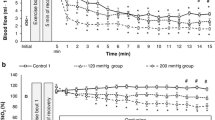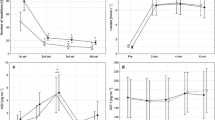Summary
16 patients with unilateral femoral occlusion of stage II and 5 healthy subjects with normal blood flow in the extremities were subjected to physical interval training for a period of 4–6 weeks, predominantly directed to the muscles of the lower legs. Before, during and after exercise the behaviour of lactate and pyruvate, the lactate and pyruvate quotient and the excess lactate of the femoral venous blood were measured. In the patients with peripheral vascular diseases the individual physical strain was continued until claudication pain occurred.
There was a clear decrease of lactate and pyruvate, of the lactate-pyruvate quotient and of excess lactate after physical training, which, in part, was above all statistically significant for lactate: the initial mean values of lactate before and after the training program were: 0.93/0.85 mM/L (p<0.05). During the load-culminating point of pain: before and after training 1.62/1.49 mM/L (p<0.05); after work 1 min (mean values) 2.09/1.79 mM/L (p<0.05), 2 min 2.10/1.72 mM/L (p<0.05), 5 min 1.71/1.41 mM/L (p<0.01), 10 min 1.38/1.18 mM/L (p<0.05), 20 min 1.11/1.05 mM/L (p>0.05), 30 min 0.91/0.90 mM/L (p>0.05).
The results suggest that effects of physical training can also be demonstrated in the metabolic field in patients with limited muscle blood flow in stage II. The factors available for muscular energy, i.g. for energy requirement and energy release which can possibly or demonstrably be influenced by training are discussed extensively.
Zusammenfassung
Bei 16 Kranken mit einem einseitig lokalisierten Femoralisverschluß im Stadium II und bei 5 Personen mit normal durchbluteten Extremitäten wurde das Verhalten von Lactat und Pyruvat sowie des Lactat-Pyruvat-Quotienten und des Exzeß-Lactats vor, während und nach Belastung im femoralvenösen Blut vor und nach einem gezielten Training vorwiegend der Unterschenkelmuskulatur über einen Zeitraum von 4–6 Wochen untersucht.
Die Ergebnisse zeigen eine Senkung von Lactat und Pyruvat sowie des Lactat-Pyruvat-Quotienten und des Exzeß-Lactats, die teilweise, vor allem im Lactatverlauf, statistisch signifikant sind Ausgangswert vor Training (\(\bar x\)) 0,93, nach Training (\(\bar x\)) 0,85 mMol/l (p<0,05). Während Belastung, dem Höhepunkt der Schmerzen:\(\bar x\) vor 1,62 mMol/l, nach Training 1,49 mMol/l (p<0,05). Nach Arbeit; 1 min: 2,09 bzw. 1,79 mMol/l (p<0,05); nach 2,5 min: 2,10 bzw. 1,72 mMol/l (p<0,05); nach 5 min: 1,71 bzw. 1,41 mMol/l (p<0,01); nach 10 min: 1,38 bzw. 1,18 mMol/l (p<0,05); nach 20 min: 1,11 bzw. 1,05 mMol/l (p>0,05); nach 30 min: 0,91 bzw. 0,90 mMol/l (p>0,05). Die Kontrollgruppe zeigte keine signifikanten Änderungen im Lactatverlauf.
Die Untersuchungen weisen darauf hin, daß sich Trainingseffekte auf metabolischer Ebene auch bei limitierter Muskeldurchblutung im Stadium II nachweisen lassen. Die Faktoren, die möglicherweise oder nachgewiesenermaßen unter diesen Bedingungen bei der muskulären Energiebereitstellung durch Training günstig zu beeinflussen sind, werden ausführlich diskutiert.
Similar content being viewed by others
Literatur
Åkeson, A., Biörk, G., Simon, R.: On the content of myoglobin in human muscles. Acta med. scand.183, 307–316 (1968).
Ahlborg, B., Bergström, J., Ekelund, L.-G., Hultman, E.: Muscle glycogen and muscle electrolytes during prolonged physical exercise. Acta physiol. scand.70, 129–142 (1967).
Alpert, N. R.: Lactate production and removal and the regulation of metabolism. Ann. N.Y. Acad. Sci.119, 995–1012 (1965).
Altland, P. D., Highman, B., Nelson, B. D.: Serum enzyme and tissue changes in rats exercised repeatedly at altitude: effects of training. Amer. J. Physiol.214, 28–32 (1968).
Anthony, A., Ackerman, E., Strother, G. K.: Effects of altitude acclimatization on rat myoglobin. Changes in myoglobin content of skeletal and cardiac muscle. Amer. J. Physiol.196, 512–516 (1959).
Åstrand, I., Åstrand, P.-O., Christensen, E. H., Hedman, R.: Myohemoglobin as an oxygen-store in man. Acta physiol. scand.48, 454–460 (1960).
Bergström, J., Hultman, E.: Muscle glycogen synthesis after exercise: an enhancing factor localized to the muscle cells in man. Nature (Lond.)210, 309–310 (1966).
Blume, F. D., Pace, N.: Effect of translocation to 3800 m altitude on glycolysis in mice. J. appl. Physiol.23, 75–79 (1967).
Bücher, Th., Czok, R., Lamprecht, W., Latzko, E.: Pyruvat. In: Methoden der enzymatischen Analyse, H. H. Bergmeyer, S. 253–259. Weinheim/Bergstraße: Verlag Chemie 1962.
Cain, D. F., Davies, R. E.: Breakdown of adenosine triphosphate during a single contraction of working muscle. Biochem. biophys. Res. Commun.8, 361–366 (1962).
Cain, St. M.: Appearance of excess lactate in anesthetized dogs during anemic and hypoxic hypoxia. Amer. J. Physiol.209, 604–610 (1965).
—— O2-deficit incurred during hypoxia and its relation to lactate and excess lactate. Amer. J. Physiol.213, 57–63 (1967).
Chapman, C. B.: Physiology of muscular exercise. Amer. Heart Ass. Monograph. No 15, 1–226 (1967).
Clausen, J. P., Trap-Jensen, J.: Effect of training on muscular blood flow during exercise. Acta physiol. scand.74, 23A (1968).
Coster, A. de, Denolin, H., Messin, R., Degre, S., Vandermotten, P.: Role of the metabolites in the acid balance during exercise. Biochemistry of exercise. Medicine and Sport, vol. 3, p. 15–34. Basel/New York: Karger 1969.
Crescitelli, F., Taylor, C.: The lactate response to exercise and its relationship to physical fitness. Amer. J. Physiol.141, 630–640 (1944).
Dawson, D. M., Goodfriend, Th. L., Kaplan, N. O.: Lactic dehydrogenases: Functions of two types. Rates of synthesis of the two mayor forms can be correlated with metabolic differentiation. Science143, 929–933 (1964).
Doll, E., Keul, J., Maiwald, Ch., Reindell, H.: Das Verhalten von Sauerstoffdruck, Kohlensäuredruck, pH, Standardbicarbonat und base excess im arteriellen Blut bei verschiedenen Belastungsformen. Int. Z. angew. Physiol. einschl. Arbeitsphysiol.22, 327–355 (1966).
Gollnick, P. D., Hearn, G. R.: Lactic dehydrogenase activities of heart and skeletal muscle of exercised rats. Amer. J. Physiol.201, 694–696 (1961).
Gould, M. K., Rawlinson, W. A.: Biochemical adaptation as a response to exercise. I. Effect of swimming on the levels of lactic dehydrogenase, malic dehydrogenase and phosphorylase in muscles of 8-, 11- and 15-week-old rats. Biochem. J.73, 41–44 (1959).
Hearn, G. R., Wainio, W. W.: Succinic dehydrogenase activity of the heart and skeletal muscle of exercised rats. Amer. J. Physiol.185, 348–350 (1956).
Hemmingsen, E. A.: Enhancement of oxygen transport by myoglobin. Comp. Biochem. Physiol.10, 239–244 (1963).
Hohorst, H.-J.: L(+)-Lactat. Bestimmung mit Lactat-Dehydrogenase und DPN. In: Methoden der enzymatischen Analyse, H. H. Bergmeyer, S. 266–270. Weinheim/Bergstraße: Verlag Chemie 1962.
Holloszy, J. O.: Biochemical adaptations in muscle. Effects of exercise on mitochondrial oxygen uptake and respiratory enzyme activity in skeletal muscle. J. biol. Chem.242, 2278–2282 (1967).
Holmgren, A., Ström, G.: Blood lactate concentration in relation to absolute and relative work load in normal men, and in mitral stenosis, atrial septal defect and vasoregulatory asthenia. Acta med. scand.163, 185–193 (1959).
Huckabee, W. E.: Control of concentration gradients of pyruvate and lactate across cell membranes in blood. J. appl. Physiol.9, 163–170 (1956).
—— Relationship of pyruvate and lactate during anaerobic metabolism. I. Effects of infusion of pyruvate or glucose and of hyperventilation. J. clin. Invest.37, 244–254 (1958).
—— Relationship of pyruvate and lactate during anaerobic metabolism. II. Exercise and formation of O2-debt. J. clin. Invest.37, 255–268 (1958).
—— Relationship of pyruvate and lactate during anaerobic metabolism. III. Effects of breathing low-oxygen gases. J. clin. Invest.37, 264–271 (1958).
Hultman, E.: Physiological role of muscle glycogen in men, with special reference to exercise. Circulat. Res. Suppl. I,20/21, 99–114 (1967).
Jagemann, K., Pansold, B., Roth, W.: Die Rolle des Laktats bei der Einschätzung des muskulären Trainingszustandes und einige kritische Bemerkungen zum “base-excess”-Laktat-Verhältnis. Med. u. Sport9, 174–179 (1969).
Jorfeldt, L.: Metabolism of L(+)-lactate in human skeletal muscle during exercise. Acta physiol. scand Suppl.338, 1–67 (1970).
Keul, J., Doll, E., Erichsen, H., Reindell, H.: Die arteriellen Substratspiegel bei Verminderung der Sauerstoffkonzentration in der Inspirationsluft während körperlicher Arbeit. Int. Z. angew. Physiol.25, 89–103 (1968).
—— —— Keppler, D.: Muskelstoffwechsel. Die Energiebereitstellung im Skeletmuskel als Grundlage seiner Funktion, S. 1–247. München: J. A. Barth 1969.
—— —— —— Reindell, H.: Die Veränderungen arterieller Substratspiegel unter dem Einfluß körperlicher Arbeit. Int. Z. angew. Physiol.22, 356–385 (1966).
—— —— —— —— Zur Bedeutung der Lactatbildung bei Intervallarbeit. Z. Kreisl.-Forsch.56, 823–830 (1967).
—— —— —— —— Intervalltraining und anaerobe Energiebereitstellung. Sportarzt u. Sportmed.18, 493–496 (1967).
—— Keppler, D., Doll, E.: Beziehung zwischen Standardbicarbonat, pH-Wert und Lactat- und Pyruvatkonzentrationen im Blut während und nach körperlicher Arbeit. Dtsch. med. Wschr.92, 66–68 (1967).
Köhler, M.: Zur konservativen Behandlung peripherer arterieller Durchblutungsstörungen. Med. Klin.64, 1536–1540 (1969).
-- Hinger, H. U.: Die Auswirkung einer gezielten milden Belastung auf das Laktat- und Pyruvatverhalten im femoralvenösen Blut bei Occlusion der Arteria femoralis. Z. Kreisl.-Forsch. (im Druck).
Landon, J., Fawcett, J. K., Wynn, V.: Blood pyruvate concentration measured by a specific method in control subjects. J. clin. Path.15, 579–584 (1962).
Laudahn, G.: Fermentaktivitäten und Konzentration von Stoffwechselzwischenprodukten im Blut bei Leber- und Herzkrankheiten. Klin. Wschr.37, 850–858 (1959).
Lawrie, R. A.: The activity of the cytochrome system in muscle and its relation to myoglobin. Biochem. J.55, 298–305 (1953).
Olson, R. E.: “Excess lactate” and anaerobiosis. Ann. intern. Med.59, 960–963 (1963).
Palladin, A., Ferdmann, D.: Über den Einfluß des Trainings der Muskeln auf ihren Kreatingehalt. Hoppe-Seylers Z. physiol. Chem.174, 284–294 (1928).
Park, C. R., Morgan, H. E., Henderson, M. J., Regan, D. M., Cadenas, E., Post, R. L.: The regulation of glucose uptake in muscle as studied in the perfused rat heart. Recent Progr. Hormone Res.17, 439 (1961).
Passonneau, J. V., Lowry, O. H., Phosphofruktokinase on the Pasteur-effect. Biochem. biophys. Res. Commun.7, 10–15 (1962).
Pattengale, P. K., Holloszy, J. O.: Augmentation of skeletal muscle myoglobin by a program of treadmill running. Amer. J. Physiol.213, 783–785 (1967).
Paul, M. H., Sperling, E.: Cyclophorase system XXIII. Correlation of cyclophorase activity and mitochondrial density in striated muscle. Proc. Soc. exp. Biol. (N.Y.)79, 352–354 (1952).
Picón-Reátegui, E.: Effect of chronic hypoxia on the action of insulin in carbohydrate metabolism. J. appl. Physiol.21, 1177–1180 (1966).
—— Effect of chronic hypoxia on the action of epinephrine in carbohydrate metabolism. J. appl. Physiol.21, 1181–1184 (1966).
Piiper, J., Cerretelli, P., Cuttica, F., Mangili, F.: Energy metabolism and circulation in dogs exercising in hypoxia. J. appl. Physiol.21, 1143–1149 (1966).
Poortmans, J. R.: Biochemistry of exercise. (Medicin and sport, 3.) Basel/New York: Karger-Verlag 1969.
Rawlinson, W. A., Gould, M. K.: Biochemical adaptation as a response to exercise. II. Adenosine triphosphatase and creatin phosphokinase activity in muscles of exercised rats. Biochem. J.73, 44–48 (1959).
Reynafarje, B.: Myoglobin content and enzymatic activity of muscle and altitude adaptation. J. appl. Physiol.17, 301–305 (1962).
Richterich, R.: Klinische Chemie, 2. erw. Ausgabe. Frankfurt a.M.: Akademische Verlagsgesellschaft 1968.
Rosenmann, M., Morrison, P.: Seasonal augmentation of myoglobin in the snowshoe hare. J. biol. Chem.240, 3353–3356 (1965).
Saltin, B., Blomquist, G., Mitchell, J. H., Johnson, R. L., Wildenthal, K., Chapman, C. B.: Response to exercise after bed rest and after training. Amer. Heart Ass. Monograph., No. 23, 1–78 (1968).
Scholander, P. F.: Oxygen transport through hemoglobin solutions. Science131, 585–590 (1960).
Scholander, P. F., Irving, L., Grinnell, S. W.: Aerobic and anaerobic changes in seal muscles during diving. J. biol. Chem.142, 431–440 (1942).
Sendroy, J., Jr.: Relationship of oxygen debt to blood lactate and pyruvate in exercised dogs. Naval Med. Res. Inst. Res. Dept.16, 787–802 (1958).
Shenk, J. H., Hall, J. L., King, H. H.: Spectrophotometric characteristics of hemoglobins. J. biol. Chem.105, 741–752 (1934).
Vogel, J. A., Hannon, J. P.: Cardiovascular and metabolic responses of dogs to exercise at high altitude. J. appl. Physiol.21/2, 1595–1601 (1966).
Wahren, J.: Quantitative aspects of blood flow and oxygen uptake in the human forearm during rhythmic exercise. Acta physiol. scand.67, Suppl. 269, 1–93 (1966).
Whipple, G. H.: The hemoglobin of striated muscle. I. Variations due to age and exercise. Amer. J. Physiol.76, 693–707 (1926).
Author information
Authors and Affiliations
Rights and permissions
About this article
Cite this article
Köhler, M. Lactat- und Pyruvatverhalten im femoralvenösen Blut vor und nach gezieltem Training bei Okklusion der Arteria femoralis. Klin Wochenschr 49, 1210–1218 (1971). https://doi.org/10.1007/BF01732729
Issue Date:
DOI: https://doi.org/10.1007/BF01732729




